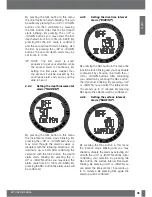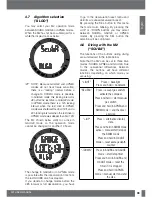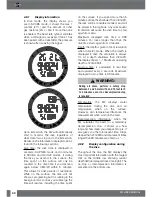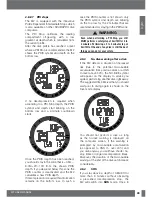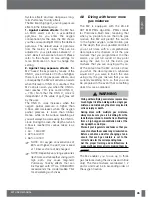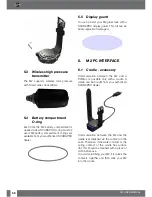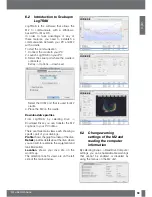
44
M2 USER MANUAL
SOS
mode the M2 will lock up and will
be inoperable as a dive computer for 24
hours. If it is used for diving within the 24
hours of an
SOS
lock, it will automatically
switch to GAUGE mode and provide no
decompression information.
WARNING
Violating a mandatory decompression obligation
may result in serious injury or fatal issue.
Serious injury or fatal issue may result if a diver
does not seek immediate treatment should any
signs or symptoms of decompression sickness
occur after a dive.
Do not dive to treat symptoms of decompression
sickness.
Do not dive when the computer is in
SOS
mode.
The display shows the same information as
when in the presence of desaturation, but
on the top row SOS is displayed.
4.8.4.1 Desaturation reset
The M2 allows you to reset the desaturation
of the computer. If tissue saturation
information from a recent dive is reset to
zero, the computer will treat the next dive
as a non-repetitive dive. This is useful when
the computer is loaned to another diver
who has not dived in the last 48 hours.
Section 4.5.5
describes how to make the
desaturation reset.
F
NOTE: After a desaturation reset the
change between GAUGE, APNEA
and SCUBA modes is possible
immediately. However, since the
GAUGE and APNEA modes are not
tracking your tissue nitrogen loading, it
is recommended to maintain the initial
intervals between changes on modes.
WARNING
Diving after having reset the desaturation
is extremely dangerous and is very likely to
cause serious injury or a fatal issue. Do not
reset the desaturation unless you have a valid
reason to do so.
F
NOTE: Removing and replacing the
battery will not reset the desaturation.
The M2 stores tissue saturation
information in a non-volatile memory.
For the time that the computer is
without a battery, the desaturation
calculation is frozen, and it picks up
from where it left off as soon as a new
battery is installed.
4.8.5
Diving with nitrox
Nitrox is the term used to describe
breathing gases made of oxygen-nitrogen
mixes with the oxygen percentage higher
than 21% (air). Because nitrox contains
less nitrogen than air, there is less nitrogen
loading on the diver’s body at the same
depth as compared to breathing air.
However, the increase in oxygen
concentration in nitrox implies an increase
in oxygen partial pressure in the breathing
mix at the same depth. At higher than
atmospheric partial pressures, oxygen
can have toxic effects on the human body.
These can be lumped into two categories:
1. Sudden effects due to oxygen
partial pressure over 1.4bar
. These are
not related to the length of the exposure
to high oxygen partial pressure. Sudden
effects can vary and depend on the exact
level of partial pressure they happen at. It is
commonly accepted that partial pressures
up to 1.4bar are tolerable, and several
training agencies advocate maximum
oxygen partial pressures up to 1.6bar.
2. Long exposure effects to oxygen
partial pressures over 0.5bar due to
repeated and/or long dives
. These can
affect the central nervous system and
cause damage to lungs or to other vital
organs. Long exposures can be divided
between more severe Central Nervous
Summary of Contents for M2
Page 1: ... M2 User Manual ...






